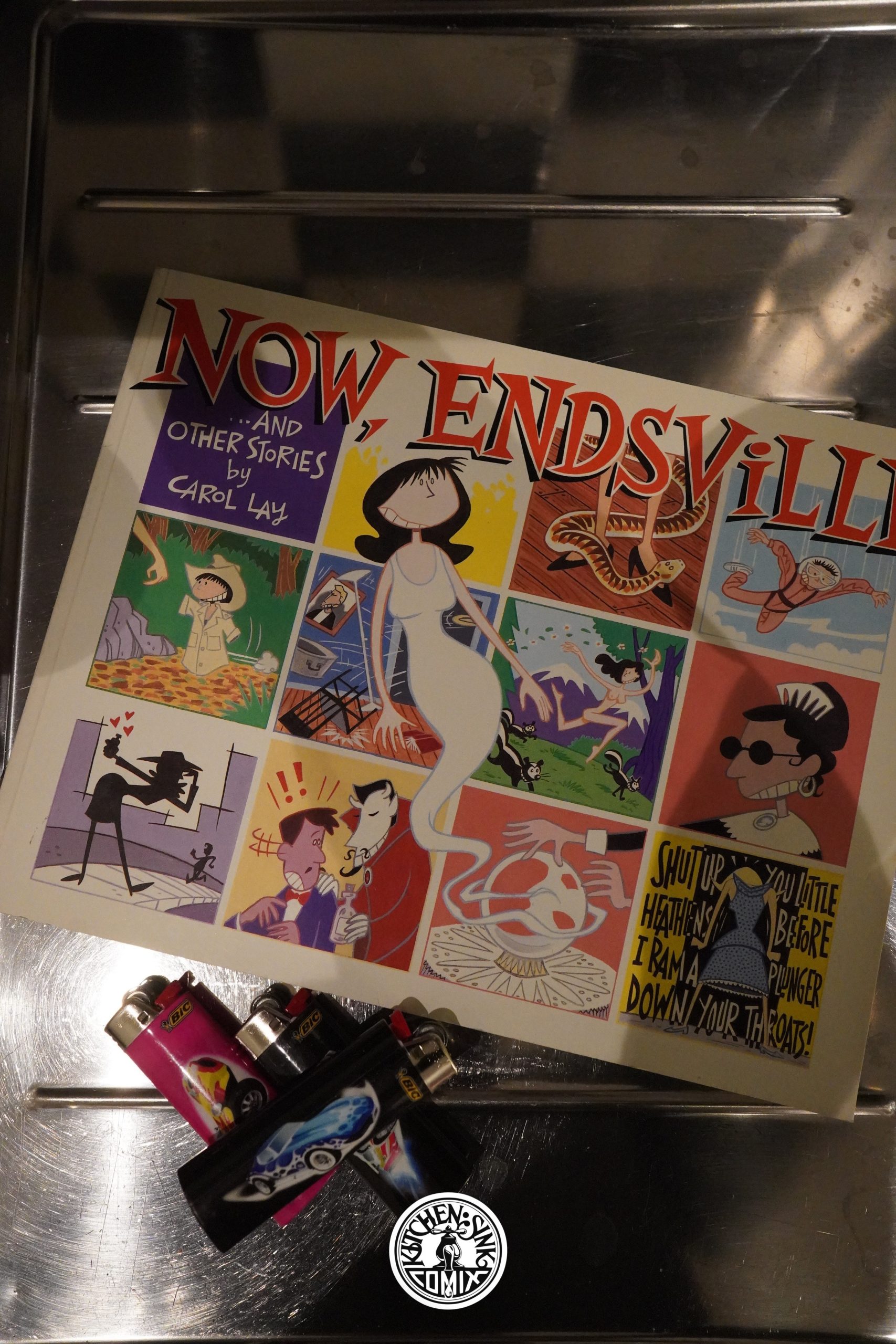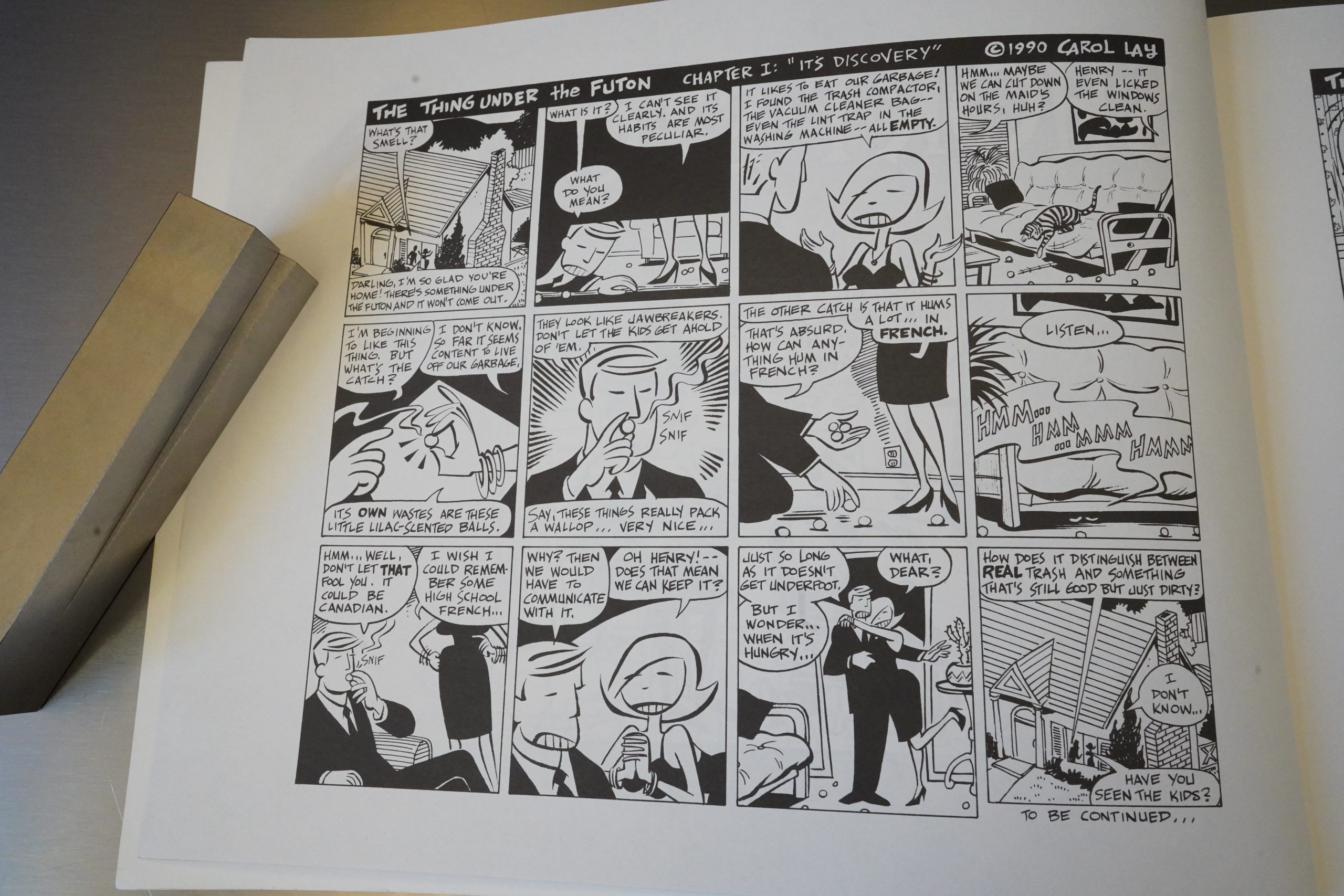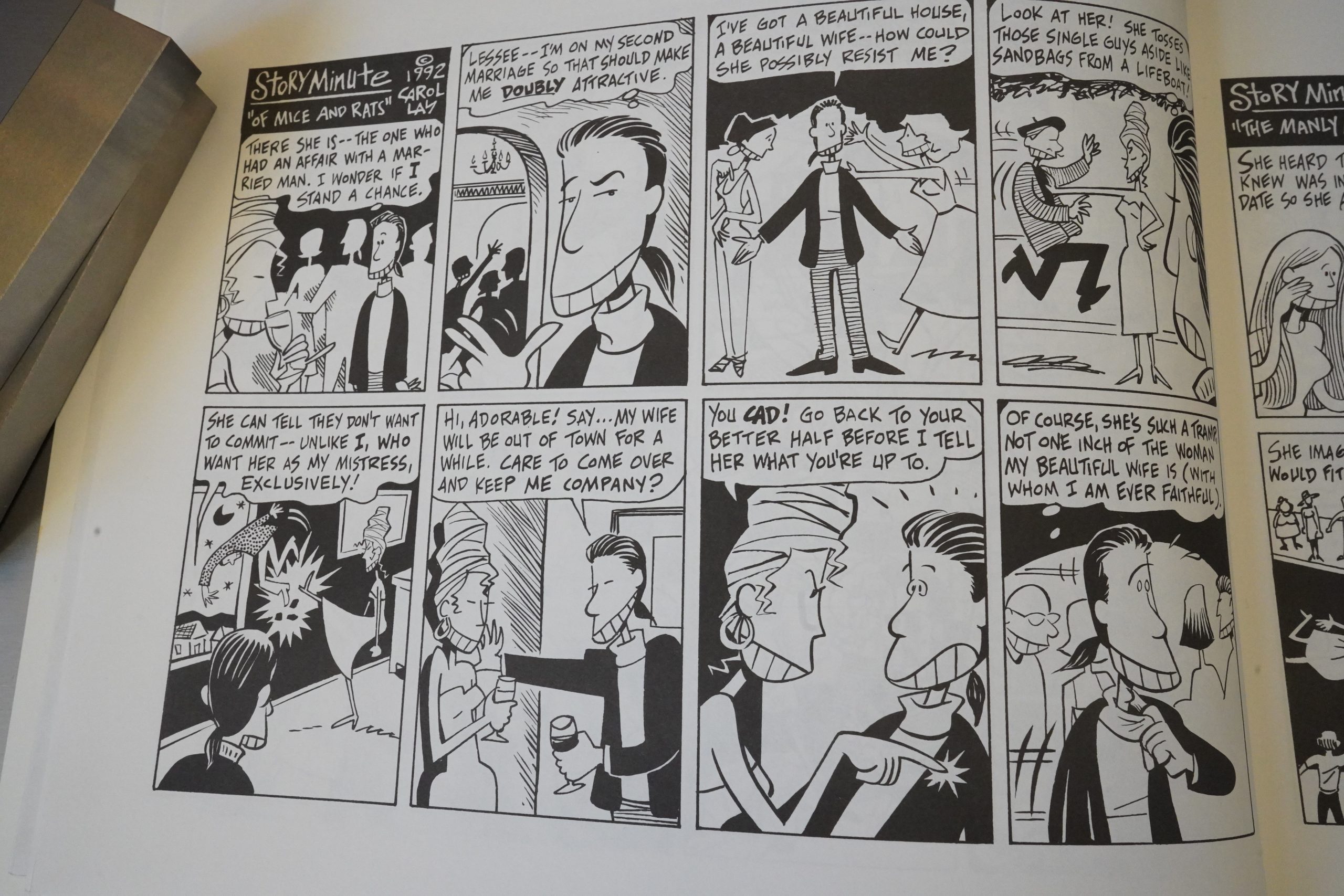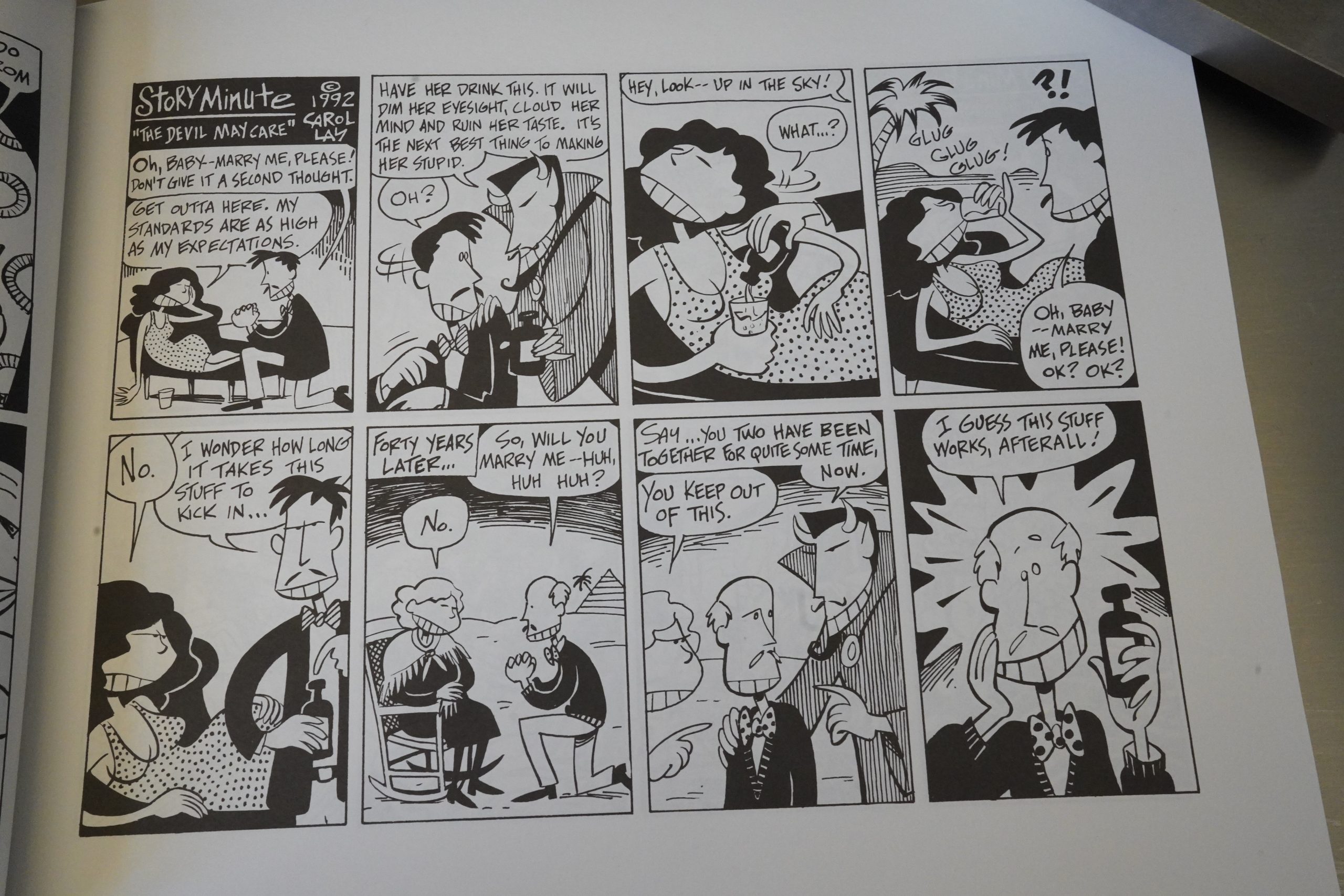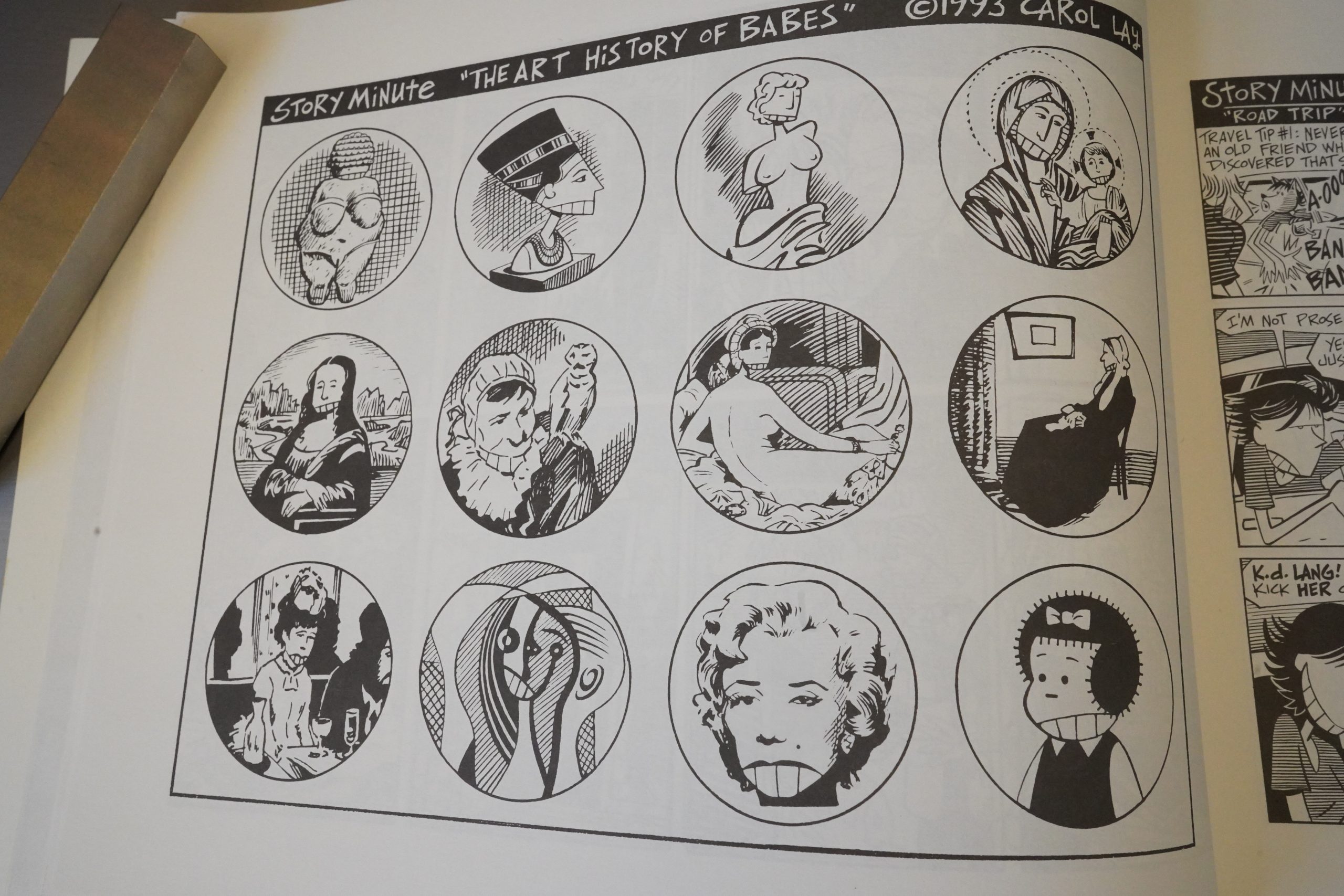Now, Endsville and Other Stories (1993) by Carol Lay
This looks like something that might have originated at the old Kitchen Sink Press? Virtually all of the books published under the “Kitchen Sink” name this year were obviously ex-Tundra books, I think, but perhaps not this one?
I was a fan of Carol Lay back in the Good Girls days — her plots were funny and her cartooning was sharp. But I never kept up with her after she started doing the Story Minute stuff…
… and I think one of the reasons is simply to do with her art style, as reductive as that may be. That is, I think her decision to invent this bizarre way of drawing faces — with teeth covering the lower portions of all faces — is just really offputting. (This is an early strip, I guess — she hasn’t perfected it yet. Look at the third panel: It looks like a downturned mouth with vertical stripes on her chin.)
It’s just… I know there are many really stylised way to draw faces in comic strips, and some are weirder than this, but I just take a look at this and go “uhm, perhaps I could be reading something else”. Yes, I’m that shallow.
So while I bought this book at the time in the 90s, I may not actually have read it until now, and I wish that I could say that I now see the error of my ways and this is really hilarious stuff, but… it isn’t. The single page strips seem to go with really forced “irony” as the main device, and to me, it doesn’t work.
This is my favourite strip in the book.
The book starts with a number of one-page strips and shorter narratives, but the bulk of the book is taken up by longer stories, like this 20+ page epic, and it’s weird how impatient that made me: Having first set up a one-page-per-thing rhythm, adjusting to these longer narratives made me constantly check how many pages I had to go.
The final thing is 40 pages, and is a really inventive story, but not really that entertaining, either?
The Comics Journal #165, page 110:
Without a doubt, Carol Lay is
one of the finest cartoonists working today. After
she finished the six-issue series Good Girls, though,
she seemed to disappear from view. her activities
unknown. Now it can be told that she been hard
at work on a weekly news,
paper strip entitled Story
Strip. Now, Endsville is
a collection of single
Story Strips as well
as several longer
stories: “Now, Ends-
Ville,” “Sweet Sue,”
and “Invisible city.”
“Now, Endsville” tells
the heart-stopping story
of love and thrill-seeking,
improbably leading to the shad-
Owy realm between life and death. “Sweet Sue,” se-
rialized in Story Strip, is a semi-cautionary tale of
the dangers of magic featuring the potion-maker
Madame Asgar, who returns in the 38-page “Invis-
ible City,” a futuristic tale of greed and forest pres-
enation. Lay has evolved a new style for her strips,
simplified, streamlined, and beautifully fluid and
coherent. It works equally as well in her short,
punchline-oriented gag strips as in the longer pieces.
Her new style also involves mouths being repre-
sented by a row Of teeth covering the bottom of the
face, a devicæ that, in Lay’s talented hands, becomes
not only effective but essential. At S9.95 for 112
soft-bound pages. Now, Endsville is a must-have
item from a must-read artist.
Lay is interviewed in The Comics Journal #213, page 75:
LAY: It started when the excellent Robert Newman, art
director, was working at theVi//age Voice. He knows
Peter Bagge from Northwest connections and for
Some reason he got the gig ofwrangling cartoon strips
for the A. Weekly. He was looking for new cartoon-
ists, got my name from Peter, and gave me a call. I
think I’d already done work for the Village Voice. He
asked me ifl wanted to do a one-to-five-page sequen-
tial strip that would fill a half of page in the LA.
Weekly. I jumped at it. At the time, I was living just
doing animation storyboards. This Was around 1990.
so I Came up with a five-page story called “The Thing
Under the Futon.”
WORCESTER: Which is a pretty bizarre story. It’s got this
sort ofnormalsurface — this suburban setting and this all-
American family.
LAY: Yeah. I like using suburban settings and putting
weird stuff in them. That, to me, is finny because I
grew up in suburbia, and it was just mind-numbing.
And in a way, a vacuum like that helps your imagina-
tion because you need something to keep you from
going crazy. Thads the first flat-out big-toothed style
storyl did. les a lot more vibrant than the way I draw
now. I wish I could get back to that really charged kind
of look — it’s goof)’ as hell. Way fewer brush lines get
a character across.
So anyway, I did those first five, and got my foot
in the door over at the IM. Weekly. When Charles
Burns quit doing his strip, I forget what year, I made
a pitch to do a weekly strip. Now Matt Groening
suggested that I do a strip years earlier, when he was
taking offwith Life in Hell. Thatwas probably the best
time to Start up a strip, because all these little papers
were being born and there weren’t so many cartoonists
to fill the spaces. But I was not ready at the time. I
didn’t have any kind of focus or really a good cartoon
style for doing that at the time. So I just took one tiny
shot at it and gave up. But by 1990, I was ready to tackle
this. So they let me do a 24-page sequence called
“Now, Endsville.” a bit Ofa science fiction fantasy
kind Of near-death experience floating around in the
after-life kind of story. There were a lot of autobio-
graphical elements in it, in that the lead character is
based on me. She’s kind of angry and desperate for
love, but basically good.
So that was running in the Ld. Weekly, and the
next paper that picked me up was the New York Press.
When I left IA, I was in those two papers. The next
paper was the San Francisco Examiner. Their Style
section was running people like Matt Groening, Nina
Paley, and I think Zippy and some others. They were
putting more alternative strips into a daily paper,
which was great for us.
I did a few self-contained strips—eight or ten Of
them. The shorter-formed strips were more gag-
oriented. After I did those short pieces, I launched into
“Invisible City,” which was 36 pages. Ifs interesting
telling a story in serialiftd form. You have to do the
recaps, but you can’t bore them by repeating your plot
thread every two minutes. That One allowed me to get
ahead on the strip so that I could pack up and move to
New York. But when I got to New York, I got a call
from Talbot at the Examiner saying, ‘The serialized
stripjust I’d gotten hate
mail to the Neu York Press to that
effect. People don’t have the attention
Span to hang onto a story week by
week If they miss a week, a big chunk
is gone, where comics used to do this
all the time — like in the old color
Sunday strips. But I think that our
culture is so speeded up that a long
story like that doesn’t have a chance in
a weekly format. But I didn’t Want to
lose the Examiner so I switched gears
and started doing one-page stories. I
called it Story Minute just because I
couldn’t think ofa better title. It pretty
much says it all — it’s a story and you
can read it in a minute even though it
takes me ten or twelve hours to draw
one.
The Comics Journal #234, page 8:
Lay is one Of the artists
whose strip was dropped from
the press when Gentile was fired.
But ironically, Gentile had
rejected her strip when she first
approached the Press approxi-
mately 10 years ago. It was
Smith, Who had seen her strip in
the L4 Weekly, who championed
her and insisted that Gentile get
her for the Press. In Lay’s early
years at the Press, Smith was so
enamored of her that he took
out an ad that repeated the
phrase “Carol Lay rules!” over
and over. But when Lay had first
approached Gentile with her 24-
part serial “Now Endsville,” she
told the Journal, “he didn’t even
look at it. He took it and tossed
it on a pile and said he didn’t
have time to read it. Then he
said, ‘You know who I’d really
like to have in here is Julie
Doucet.’ I couldn’t believe he
could be that rude. That’s like
getting Out Of bed with someone
and saying, ‘You know Who
really like to fuck?'”
Indeed the narrow market
for alternative weekly strips
encourages a competitiveness
that is not unlike sexual rivalry.
The nature Of that courtship is
made all the more personal by
the way that each alternative
weekly tends to take on a per-
sonality of its own, often the
extension Of key individuals like
Smith, Gentile or Strausbaugh.
“Every paper has its own wacky
editor at the helm,” Lay said.
“And as soon as they leave, a new
person comes in and has to
change everything. It doesn’t
matter how many readers 100k
forward to seeing your strip
every week.
Much of Now, Endsville is entertaining fun, yet it’s not Lay at her peak, and most material collected in her later books is.
And it’s on Paul Gravett’s 1001 comics you must read before you die or something.
This is the one hundred and fifty-fourth post in the Entire Kitchen Sink blog series.

